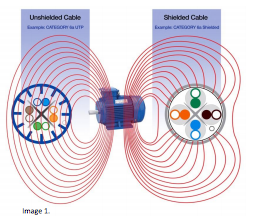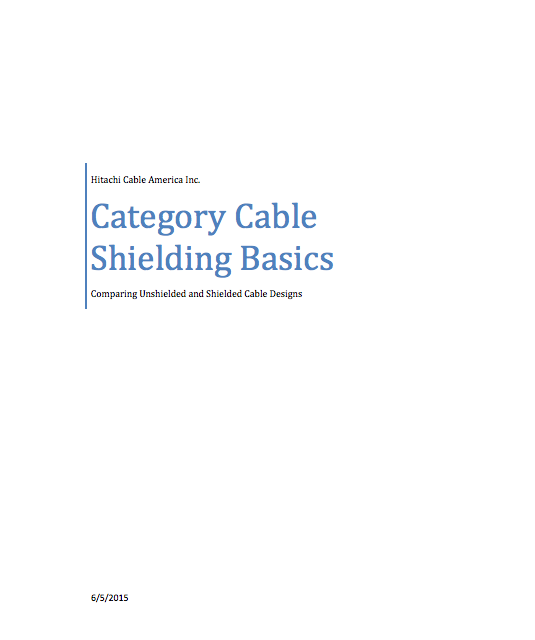Shielding basics and performance – Comparing UTP and Shielded Cable designs
Hitachi Cable America, a leading nationwide manufacturer of cabling solutions, recently published this new white paper on shielding basics. Read the excerpt below or download the full version by clicking here.
A cable shield provides a protective barrier from external electrical fields around the cable. The shield, a conductive metallic foil with a polyester backing, surrounds the cable pairs and helps prevent extraneous voltages from influencing the signal on the pairs beneath the shield layer. Image 1 illustrates how external electrical fields interact with an unshielded twisted pair cable (UTP) and a twisted pair cable with an overall shield (F-UTP). The shield on the F-UTP cable actually causes the electrical fields to bend around the cable such that the voltage at the surface of the shield is practically at ground potential. The amount of external field energy within the shield is essentially zero. By contrast, the electrical fields surrounding a UTP cable penetrate the jacket and directly interact with the pairs. Without a shield, only the pair twist and pair balance help offer immunity to the noise.
 Industry standards such as ANSI/TIA-JSTD-607-B provide requirements for bonding and grounding of a telecommunication infrastructure. Bonding and grounding are a critical component of any telecommunications infrastructure. The standard was established to ensure that the telecommunications infrastructure will have only one electrical ground potential. Different ground potentials can occur when a ground in part of a building is of a different voltage than that of another part of the building. This situation can then result in unwanted voltage on a circuit, also known as a ground loop. This unwanted voltage can impact network equipment by disrupting video signals, corrupting data transmissions, and, if significant enough, pose an electrical shock hazardous to users.
Industry standards such as ANSI/TIA-JSTD-607-B provide requirements for bonding and grounding of a telecommunication infrastructure. Bonding and grounding are a critical component of any telecommunications infrastructure. The standard was established to ensure that the telecommunications infrastructure will have only one electrical ground potential. Different ground potentials can occur when a ground in part of a building is of a different voltage than that of another part of the building. This situation can then result in unwanted voltage on a circuit, also known as a ground loop. This unwanted voltage can impact network equipment by disrupting video signals, corrupting data transmissions, and, if significant enough, pose an electrical shock hazardous to users.
Click here to download the full white paper.
Click here to contact your local Accu-Tech representative today.



.png?width=58&height=58&name=X_logo_2023_(white).png)
